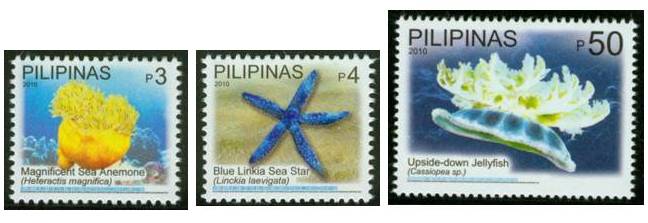2010, December 3. Philippine Marine Biodiversity - Definitives
Litho Offset. Amstar Company, Inc. Perf. 13.5
3p, 4p Singles, Sheets of 100 (10 x 10); 50p Singles, Sheets of 50 (5 x 10)

3p - Magnificent Sea Anemone - Singles (400,000)
4p - Blue Linkia Sea Star - Singles (330,000)
50p - Upside-down Jellyfish - Singles (215,000)
Source: Coral Reef Animals of the Indo-Pacific by Dr. Terence Gosliner
First Day Covers: Manila
Magnificent Sea Anemone. Also known as Ritteri Anemone Heteractis magnifica has a sticky foot at the base of the pedal column that is used to adhere to various surfaces. They also use the "foot" to move around if conditions are not ideal. The foot tends to be much larger than the column in comparison to other anemones. Tentacles are all over the surface of the oral disc. The approximately 3" long tentacles are finger-shaped and some may be branched. They are topped with spherical or bulb shaped tips which are lighter and usually colored an iridescent yellowish green. When this anemone feels threatened, it will retract all its tentacles and form a large ball. It can grow up to 39" (100 cm), but it is unknown how long they live.
(http://animal-world.com/encyclo/reef/anemones/MagnificentSeaAnemone.php)
Blue Linckia Sea Star. Also known as the Comet Sea Star, Blue Sea Star, or Blue Starfish. The unusual blue color of this sea star is truly remarkable. Its bright blue body may sometimes be embellished with red or purplish spots. In the wild, the Blue Linckia Sea Star is found in the sunny areas of the reef and reef fringe, constantly foraging for food . As a juvenile (when it has a blue-green coloration), the Blue Linckia Sea Star spends most of the day hiding in small caves or overhangs. As a larger adult, it can be seen anchored to the rocks or glass, waving one or two arms in the water, searching for small, free-floating microbes.
(http://www.liveaquaria.com/product/prod_display.cfm?c=497+528+568&pcatid=568)
Upside-down Jellyfish. So called because it tends to stay upside down in shallow, muddy waters that it inhabits. This jellyfish looks less like a jellyfish and more like a sea anemone. Its appearance is such that it can be easily mistaken for a bluish green water flower. However, this appearance of the upside down jellyfish is very important for its survival. Its appearance provides it a very good camouflage against its predators. Apart from its appearance, the upside down jellyfish is unique in another important aspect. Instead of just hunting its own food, the upside down jellyfish depends upon unicellular algae, called zooxanthellae, for partial nutrition. The algae use photosynthesis to create nutrition from sunlight. The nutrition created by the algae is absorbed by the upside down jellyfish for its own survival. This symbiotic relationship between the upside down jellyfish and the algae is the reason for the upside down nature of the jellyfish. The algae reside inside the bell of the jellyfish and it needs sunlight to photosynthesize food. To enable the algae to access sunlight, the jellyfish floats upside down in water. This is also why the upside down jellyfish resides in shallow water. That way they can settle upside down on the bed of the water body, while providing ample sunlight to the algae inside its bell. There is another interesting aspect to the upside down jellyfish. Instead of having a single primary mouth, the upside down jellyfish has a primary mouth and a series of secondary mouths. The primary mouth is used to break the food down into small particles, which are then ingested by the secondary mouths. (http://www.jellyfishfacts.net/upside-down-jellyfish.html)
-
Marine Biodiversity
-
Marine Life
